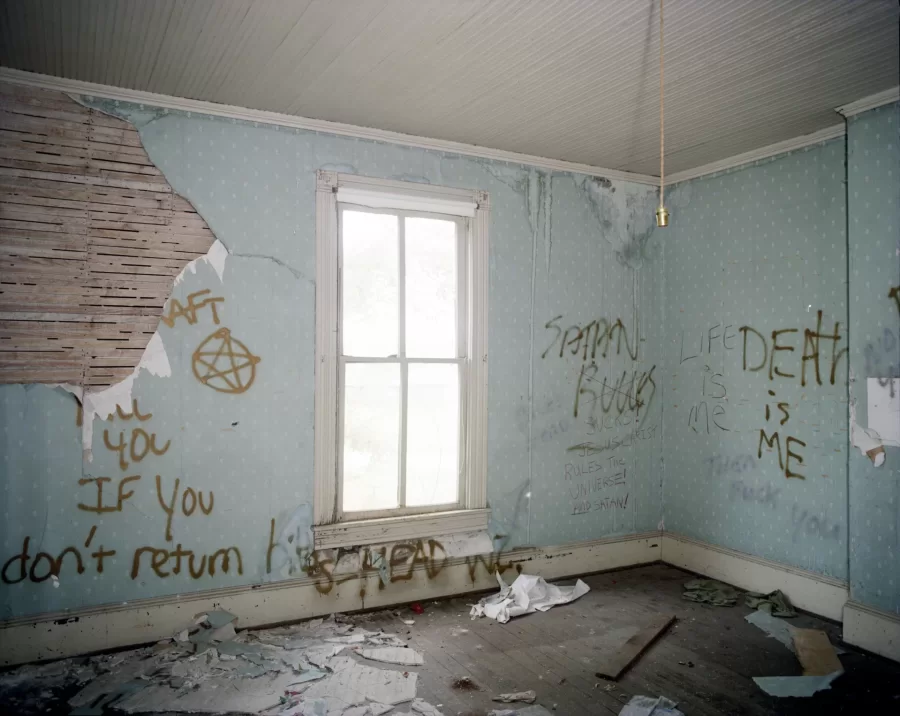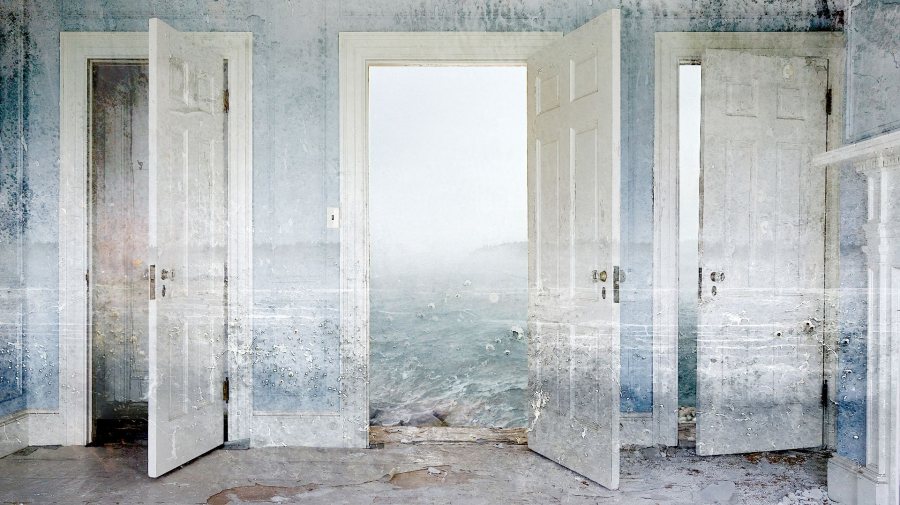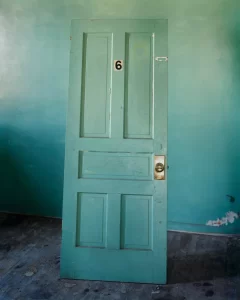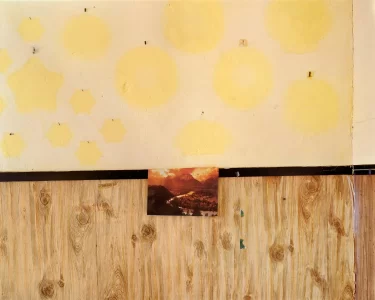Collection Highlights: Shellburne Thurber’s Palimpsests of Place

“What’s intriguing about interiors is what they have to say about the people who live in them.”
– Shellburne Thurber1
Photographer Shellburne Thurber depicts the physical spaces where intimate experiences occur–and the loss of those memories and places over time–through her series of abandoned homes, psychologist offices, motel rooms, emptied city buildings, and deceased family members’ residences. In these, saturated colors in the layers of walls and windows infuse an eerie emotional tenor where the presence of people is still palpable, although past.
Using light, color, framing, and angles, Beechwood: Blue Bedroom with Graffiti and Damaged Wall—from her series of abandoned homes in the South—creates a familiar yet uncomfortable emptiness that immediately caused me to pause.2 As a scholar within the intersections of place and art, and a curator who recently mounted an exhibition about domesticity and aesthetic practice in the Arkansas Ozarks, I am called to sit with Thurber’s Home series.. It is surprisingly devoid of notions of romanticism, the Southern Gothic, nostalgia, or stories of hardship that so often plague images related to the South. Instead, it is filled with a quiet, honest, and impactful reverence for the lives lived in these environments.
As I have seen in my work, homes escape notice, often because they are so familiar to us. But, just like portraying the human figure might represent an essence of personhood, Thurber sees these photographs as portraits of the unnamed people who once inhabited them, and of the artist herself, who conveys her experience interacting with the essence of the home. With the masterful play of light, the opaque and diffused sun, and the walls’ layered graffiti and colors, her photography transforms this forgotten place into a type of vernacular spiritual architecture. Thurber’s images are not merely in color; they radiate with it, so saturated that their light and color seem to glow from within, and give a new life to these decaying interiors.3
Devoid of many objects, in Beechwood, we can only make conjectures about who picked out the baby blue wallpaper for the bedroom and why. Very present are the layers of graffiti, like those in bar bathroom stalls that argue with one another through paint and marker. This is a literal writing on the wall of life after domesticity. But rather than depicting the graffiti as sinister, it too is part of the full picture portrayed with soft light, equaling out the stories. Since this series of photographs was taken in the 1990s, it is hard not to place these texts on the wall within the context of the Satanic Panic era when –especially in the South—adults struck out against teenagers who wore black, played violent video games, and listened to metal as potentially participating in murderous satanic cults. Perhaps these graffitiers were teenagers playing out this battle in real time through the abandoned home’s walls. These former inhabitants and interlocutors are defined, not by what they took, but by what they chose to leave behind. Thurber’s spaces, though, are not in torment; they are quiet, peaceful, and accepting.4 Of these layers, Thurber states, “I’m interested in how these houses have provided protection for these people that I don’t know.”5
Thurber emphasizes that these are her experiences in homes as part of her own grappling with loss, change, and decay in the human experience and present within our own bodies. Her work is inspired by phenomenological artists who play with space, color, and light to change spaces, experiences, and emotions, like James Turrell and Marc Rothko. Her work retains some similarity to the interiors of Jeffery Becton, who had a solo exhibition at Bates in 2015. Whereas Becton creates altered realities rich in symbolism through digital montages, she does not superimpose or manipulate her photography, preferring to remain in the present with the conditions at hand in the environment..

Bates College Museum of Art, 2017.38.14
These works also remind me of Alec Soth, specifically Sleeping by the Mississippi (2004), but Soth’s sense of place and abandonment deals with specific places and people, as well as the time-based artist’s journey, while Thurber’s pieces depict intimate spaces that could be anywhere. She has also been placed with the Boston School of photographers like Nan Goldin and Mark Morrisroe, who centered closeness through the act of photographing. These artists saw the self as architectural as well, surrounded by what they inhabited.6
Thurber still uses the architectural interior as a metaphor for people; “I’ve always seen homes as surrogates for human presence. Homes are places that supposedly nurture you and protect you. In that way they’re an architectural stand-in for the mother.”7 This mothering Thurber found through photographing the places her own mother frequented in order for the artist to better know her after her death. This activated Thurber’s process of photographing interiors. Yet Thurber refuses to fetishize objects—those crumbling homes that everyone loves to snap as they pass by—even while her own meditative process of light, space, and personal life seep through her work to focus on an inner reality of decay, loss, and reverence.8 Perhaps, her photographs lie somewhere in between interpretations, giving them this enigma that skirts the line between truth and mystery— and made me stop at this photograph of an old home interior in the first place.
Citations
1 Home: Photographs by Shellburne Thurber, (Boston: ICA Boston, 1999) 4.
2 Ibid.
3 Lee Zacharias, “Shellburne Thurber’s Southern Home,” Southern Cultures, Vol. 10, No. 3 (Fall 2004), 32.
4 Ibid., 46.
5 Home, 14
6 Lia Gangitano, editor. Boston School (Boston: The ICA, Boston/Primal Media, 1995) 12.
7 “Shellburne Thurber’s Southern Home,” 35.
8 Ibid., 50.

